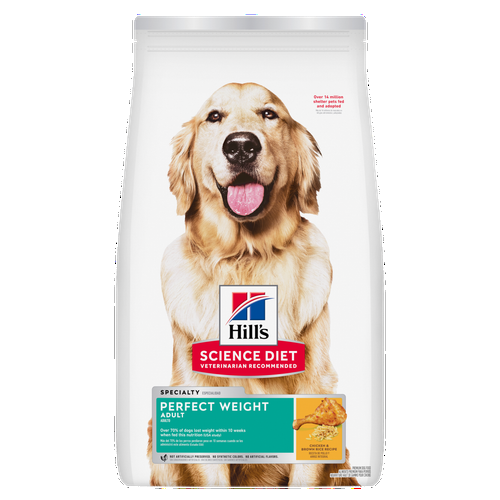
-
Find the right food for your pet
Take this quiz to see which food may be the best for your furry friend.
Find the right food for your pet
Take this quiz to see which food may be the best for your furry friend.
Featured products
 Perfect Digestion Small Bites Chicken, Brown Rice & Whole Oats Recipe Dog Food
Perfect Digestion Small Bites Chicken, Brown Rice & Whole Oats Recipe Dog FoodScience Diet's breakthrough nutrition supports ultimate digestive well-being & healthy microbiome. Delicious food in a small bite size
Shop Now Adult Large Breed Chicken & Barley Recipe Dog Food
Adult Large Breed Chicken & Barley Recipe Dog FoodSupports healthy joints, lean muscle, and beautiful coat for large breed dogs
Shop Now Puppy Small Paws Chicken & Barley Entrée
Puppy Small Paws Chicken & Barley EntréeChicken & Barley recipe with great taste and precisely balanced nutrition to help your puppy build immunity and strong bones
Shop Now -
Dog
- Dog Tips & Articles
-
Health Category
- Weight
- Food & Environmental Sensitivities
- Urinary
- Digestive
- Joint
- Kidney
-
Life Stage
- Puppy Nutrition
- Adult Nutrition
- Senior Nutrition
Cat
- Cat Tips & Articles
-
Health Category
- Weight
- Skin & Food Sensitivities
- Urinary
- Digestive
- Kidney
-
Life Stage
- Kitten Nutrition
- Adult Nutrition
Featured articles
 The Incredible Science Behind Your Pet's Microbiome
The Incredible Science Behind Your Pet's MicrobiomeLearn what a pet's microbiome is, how it contributes to your pet's gut & overall health, and why nutrition is important in maintaining healthy microbiomes.
Read More Water
WaterDiscover why water is the most important nutrient for your dog or cat to live a healthy life. Find out how much water your pet should consume each day.
Read More Pet Food Storage Tips
Pet Food Storage TipsDiscover how and where to store your dry, as well as canned, dog and cat food. Learn how to find the "best before" dates on all Hill's pet food packaging.
Read More -
Find the right food for your pet
Find the right food for your pet


Some dogs get upset when their pet parents leave. After all, they generally don't like to be left alone or be apart from their best friend. How can you tell whether your pup is merely bummed you're running an errand or is suffering from something more serious? Use the following tips to spot separation anxiety in dogs and help restore their calm when they're feeling most lonely.
Is It True Separation Anxiety?
Dogs with separation anxiety go beyond simply pouting or whining when you leave them. Separation anxiety manifests in destructive or self-harming behavior that can include soiling in the house, tearing up their surroundings and even occasionally injuring themselves while attempting to get out. Other symptoms include vocalizing excessively, refusing to eat or drink and incessant panting or salivating. Many pups with separation anxiety don't respond well to being crated either.

It's important to keep in mind, though, that many of these symptoms can also reflect other conditions, which makes separation anxiety hard to properly diagnose. If your dog relieves themself in the house while you're gone, for example, there are still a number of possible causes — including improper house training or incontinence due to a physical condition. Excessive panting, salivating and refusing to eat or drink could also signal another medical condition such as dehydration. Some dogs also simply have rambunctious personalities that turn items in their surroundings into collateral damage.
The key is to determine whether these behaviors only occur when your dog is left alone, and to rule out familiar causes such as a medical condition or the dog's age and personality. In the case of separation anxiety, destructiveness is usually specific to the desire to escape. Chewing your favorite pair of shoes while you're gone, on the other hand, is often them just being a dog. But if they chew and scratch the wallpaper, they may very well be desperate to get out — a telltale sign of separation anxiety in dogs. Another sign is if these are new behaviors that your dog hasn't normally exhibited, especially if you are away more often than in the past.


Tasty Tips
Preventing This Stress
Although it remains a mystery as to what causes certain dogs to feel this way over others, some triggers have been identified. According to Pet Health Network, these include:
- Over-attachment to their human guardian due to how they were raised as a puppy
- Underlying emotional issues such as fear and nervousness
- Having been rehomed or spent time in a shelter or kennel
- Sudden change in household routine or structure, such as the loss of a family member or other pet
As far as it's in your power to do so, helping your dog cope if they're faced with any of these scenarios will prevent them from developing separation anxiety in the first place. Planning to board them at a kennel for a few days while you're out of town? Ease into it ahead of time by taking them there to visit, and leave a favorite toy or an old tee-shirt covered in your scent to comfort them during their stay. And if any major changes occur at home, be sure to lavish attention on your buddy to help reassure them they're still safe and secure.

If your dog is already suffering from separation anxiety, the key to treating the disorder is to help them overcome their "fear." Best Friends recommends pretending to leave the house by putting on your shoes and coat, grabbing your keys and heading toward the door as though you're about to leave — but don't. Do this as many as ten times a day until you begin to notice a change in your dog's behavior. An experienced dog trainer or animal behaviorist may be able to help you determine solutions, too. In the meantime, your dog's veterinarian may prescribe anti-anxiety medications to help calm them while you work on nudging their reactions in a better direction.
The American Society for the Prevention of Cruelty to Animals (ASPCA) also points out that it's important to provide your pet with plenty of mental and physical stimulation. Vigorous exercise, daily walks and interactive play can all go a long way toward keeping their confidence once you leave. Providing mentally stimulating toys, such as food or puzzle toys, gives them something to keep their mind occupied with in your absence. And of course, showering your dog with love and attention when you're with them will remind them they can depend on you no matter where you are. If you suspect they have separation anxiety, talking to your vet about the signs is a good starting point. With a proper diagnosis, an action plan can teach them to overcome it. By consistently carrying out that plan, your pal stands an excellent chance of having calmer, happier alone time.


Amy Shojai, is a certified animal behavior consultant, and nationally known authority on pet care and behavior. She began her career as a veterinary technician and is the award-winning author of more than 35 prescriptive nonfiction pet books.
Related products

Vital nutrients to support 5 essential building blocks for lifelong health

Highly digestible recipe, gentle on stomachs. Nourishes skin & promotes a lustrous coat

Supports lean muscle and beautiful coat for adult dogs

Over 70% of dogs lost weight within 10 weeks when fed this nutrition (USA Study)
Related articles

Understand the role that Omega-6 and Omega-3 fatty acids play in your dog's overall health, and how you can ensure they are getting enough.

Proper nutrition for your pregnant or nursing dog is vital to her and her puppy's health. Learn what you should do provide her with the proper nutrients.

Learn about Hill's puppy food and the nutritional benefit & high quality ingredients that it contains for your pup.

Large and giant breed puppies have different nutritional needs than other dogs. Learn how to provide the special care they need to grow up big and strong.

Put your dog on a diet without them knowing
Our low calorie formula helps you control your dog's weight. It's packed with high-quality protein for building lean muscles, and made with purposeful ingredients for a flavorful, nutritious meal. Clinically proven antioxidants, Vitamin C+E, help promote a healthy immune system.
Put your dog on a diet without them knowing
Our low calorie formula helps you control your dog's weight. It's packed with high-quality protein for building lean muscles, and made with purposeful ingredients for a flavorful, nutritious meal. Clinically proven antioxidants, Vitamin C+E, help promote a healthy immune system.




